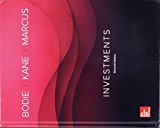
a.
To calculate:The intrinsic value when GE’s P/E ratio starting in 2020 will be 16.
Introduction:
Unlevered Beta: This is also called as asset beta. It is one of the risk measurement unit which is used to compare the risk of company that doesnot have any debts with that of risk of the markets. In other words, risk of the company without dedts and risk of the market is compared.
a.
Answer to Problem 16PS
The intrinsic value when P/E ratio in the year 2020 is 16 will be $111868 and of FCFE will be $77595.80.
Explanation of Solution
Given information:
Spreadsheet 18.2 −
| 2016 | 2017 | 2018 | 2019 | 2020 | ||
| A.Input data | ||||||
| P/E | 14.35 | 14.25 | 14.17 | 14.08 | 14 | |
| Cap spending'shr | 2.65 | 2.7 | 2.82 | 2.93 | 3.05 | |
| LT Debt | 30000 | 28500 | 27333 | 26167 | 25000 | |
| Shares | 1800 | 1800 | 1798 | 1797 | 1795 | |
| EPS | 3.1 | 3.75 | 3.83 | 3.92 | 4 | |
| Working capital | 36825 | 37750 | 41173 | 44597 | 48020 | |
| Discount rate calculations | ||||||
| Current beta | 0.95 | |||||
| unlevered beta | 0.767 | |||||
| terminal growth | 0.02 | |||||
| tax_rate | 0.35 | |||||
| r.debt | 0.036 | |||||
| risk-free rate | 0.02 | |||||
| market risk premium | 0.08 |
The formulas to be entered in the cells are as follows:
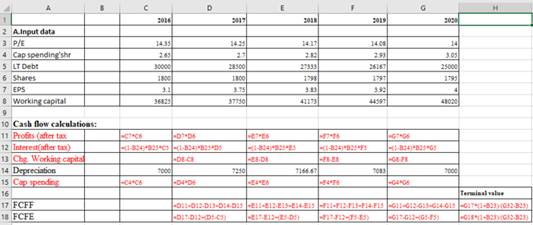
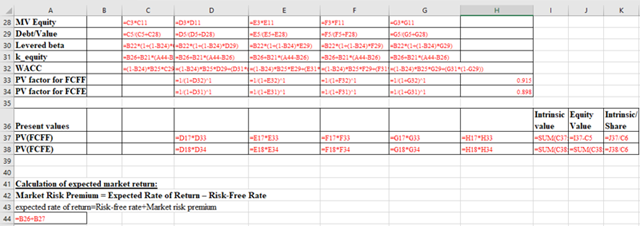
After inputing the required value in the cell related to G3, we get the following values.
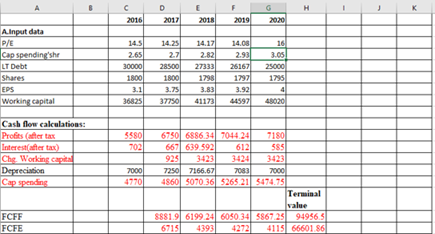
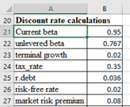
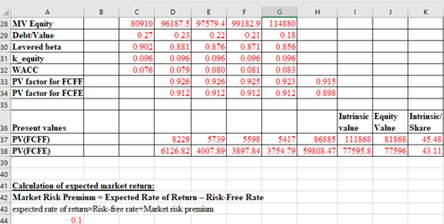
Therefore the intrinsic value when P/E ratio in the year 2020 is 16 will be $111868 and of FCFE will be $77595.80
b.
To calculate: The intrinsic value when GE’s unlevered beta is 0.80.
Introduction:
Unlevered Beta: This is also called as asset beta. It is one of the risk measurement unit which is used to compare the risk of company that doesnot have any debts with that of risk of the markets. In other words, risk of the company without dedts and risk of the market is compared.
b.
Answer to Problem 16PS
The intrinsic value of FCFF is $113972 and FCFE is $79038.50.
Explanation of Solution
Given information:
Spreadsheet 18.2 − Free cash flow model
| 2016 | 2017 | 2018 | 2019 | 2020 | ||
| A.Input data | ||||||
| P/E | 14.35 | 14.25 | 14.17 | 14.08 | 14 | |
| Cap spending'shr | 2.65 | 2.7 | 2.82 | 2.93 | 3.05 | |
| LT Debt | 30000 | 28500 | 27333 | 26167 | 25000 | |
| Shares | 1800 | 1800 | 1798 | 1797 | 1795 | |
| EPS | 3.1 | 3.75 | 3.83 | 3.92 | 4 | |
| Working capital | 36825 | 37750 | 41173 | 44597 | 48020 | |
| Discount rate calculations | ||||||
| Current beta | 0.95 | |||||
| unlevered beta | 0.767 | |||||
| terminal growth | 0.02 | |||||
| tax_rate | 0.35 | |||||
| r.debt | 0.036 | |||||
| risk-free rate | 0.02 | |||||
| market risk premium | 0.08 |
The formulas to be entered in the cells are as follows:
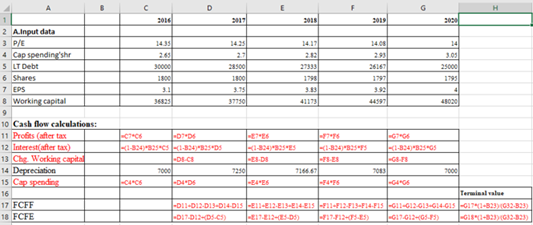
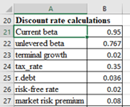
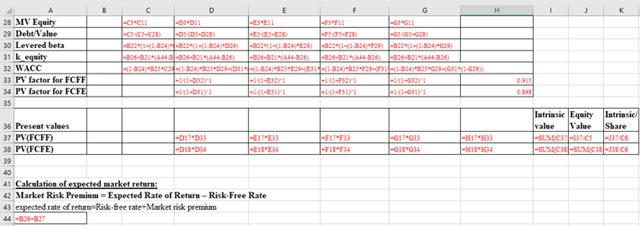
We need to change the vaue of unlevered beta from 0.767 to 0.80. After inputing the required value in the cell related to B22, we get the following values.
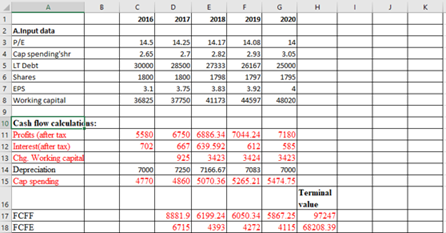
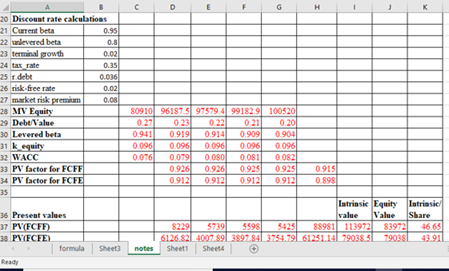
Therefore, the intrinsic value of FCFF is $113972 and FCFE is $79038.50.
c.
To calculate: Intrinsic value when the market risk premium is 7.5%
Introduction:
Unlevered Beta: This is also called as asset beta. It is one of the risk measurement unit which is used to compare the risk of company that doesnot have any debts with that of risk of the markets. In other words, risk of the company without dedts and risk of the market is compared.
c.
Answer to Problem 16PS
The intrinsic value of FCFF will be$ 119921 and for FCFE it will be $83151.40.
Explanation of Solution
Given information:
Spreadsheet 18.2 − Free cash flow model
| 2016 | 2017 | 2018 | 2019 | 2020 | ||
| A.Input data | ||||||
| P/E | 14.35 | 14.25 | 14.17 | 14.08 | 14 | |
| Cap spending'shr | 2.65 | 2.7 | 2.82 | 2.93 | 3.05 | |
| LT Debt | 30000 | 28500 | 27333 | 26167 | 25000 | |
| Shares | 1800 | 1800 | 1798 | 1797 | 1795 | |
| EPS | 3.1 | 3.75 | 3.83 | 3.92 | 4 | |
| Working capital | 36825 | 37750 | 41173 | 44597 | 48020 | |
| Discount rate calculations | ||||||
| Current beta | 0.95 | |||||
| unlevered beta | 0.767 | |||||
| terminal growth | 0.02 | |||||
| tax_rate | 0.35 | |||||
| r.debt | 0.036 | |||||
| risk-free rate | 0.02 | |||||
| market risk premium | 0.08 |
The formulas to be entered in the cells are as follows:
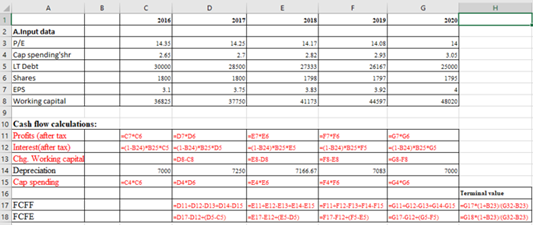
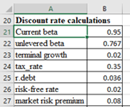
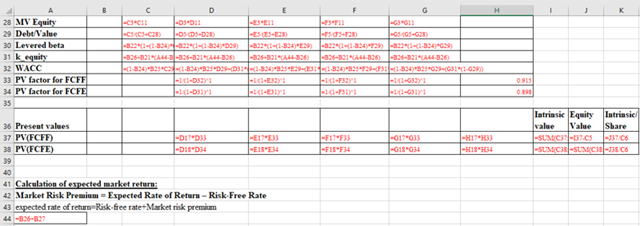
We need to change the vaue of unlevered beta from 0.08 to 0.075. After inputing the required value in the cell related to B27, we get the following values.
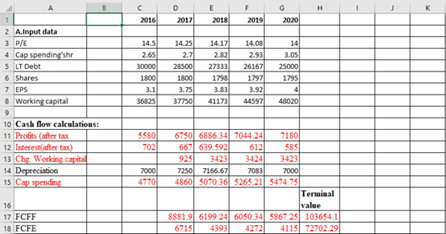
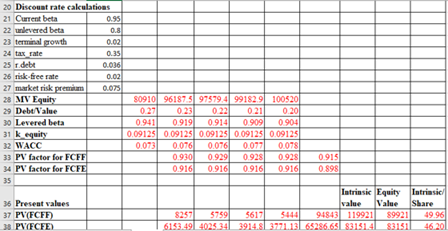
Therefore the intrinsic value of FCFE will be$ 119921 and for FCFE it will be $83151.40.
Want to see more full solutions like this?
Chapter 18 Solutions
Investments, 11th Edition (exclude Access Card)
- Please help me with this , with tge store name puebleo in St. Thomas US virgin islandsarrow_forwardI would like to expand pueblo in S5. Thomas virgin islands to Spain. Please help with an analysis expansion.arrow_forwardPlease help me with this, guidelines for the super market pueblo in St. Thomas US virgin islandsarrow_forward
- Need the below table filled out for Short-term debt %, Long-term debt $,%, Common equity $,% and Total capital $,%. Market Value Capital Structure Suppose the Schoof Company has this book value balance sheet: Current assets $30,000,000 Current liabilities $20,000,000 Notes payable 10,000,000 Fixed assets 70,000,000 Long-term debt 30,000,000 Common stock (1 million shares) 1,000,000 Retained earnings 39,000,000 Total assets $100,000,000 Total liabilities and equity $100,000,000 The notes payable are to banks, and the interest rate on this debt is 11%, the same as the rate on new bank loans. These bank loans are not used for seasonal financing but instead are part of the company's permanent capital structure. The long-term debt consists of 30,000 bonds, each with a par value of $1,000, an annual coupon interest rate of 6%, and a 15-year maturity. The going rate of interest on new long-term debt, rd, is 12%, and this is the…arrow_forwardNed assistance with Q3 and Q4 below? Cost of Equity The earnings, dividends, and stock price of Shelby Inc. are expected to grow at 6% per year in the future. Shelby's common stock sells for $21 per share, its last dividend was $1.00, and the company will pay a dividend of $1.06 at the end of the current year. Using the discounted cash flow approach, what is its cost of equity? Round your answer to two decimal places. 11.06 % If the firm's beta is 1.3, the risk-free rate is 8%, and the expected return on the market is 11%, then what would be the firm's cost of equity based on the CAPM approach? Round your answer to two decimal places. 11.90% If the firm's bonds earn a return of 9%, then what would be your estimate of rs using the own-bond-yield-plus-judgmental-risk-premium approach? (Hint: Use the mid-point of the risk premium range.) Round your answer to two decimal places. % On the basis of the results of parts a–c, what would be your estimate of Shelby's cost of equity?…arrow_forwardWhat monthly compounded interest rate would Second National Bank need to pay on savings deposits to provide an effective rate of 6.2%?arrow_forward
 EBK CONTEMPORARY FINANCIAL MANAGEMENTFinanceISBN:9781337514835Author:MOYERPublisher:CENGAGE LEARNING - CONSIGNMENT
EBK CONTEMPORARY FINANCIAL MANAGEMENTFinanceISBN:9781337514835Author:MOYERPublisher:CENGAGE LEARNING - CONSIGNMENT
